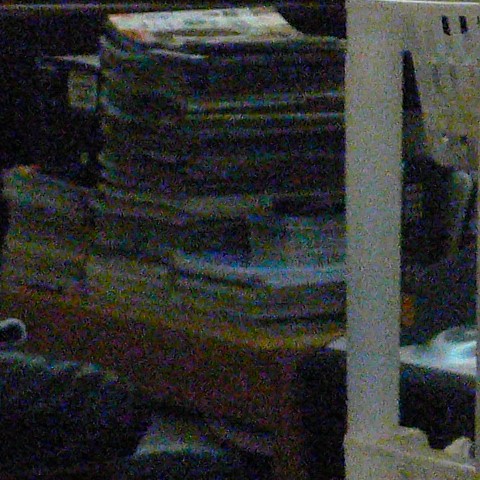|
Contrast-to-noise Ratio
Contrast-to-noise ratio (CNR) is a measure used to determine image quality. CNR is similar to the metric signal-to-noise ratio (SNR), but subtracts a term before taking the ratio. This is important when there is a significant bias in an image, such as from haze. As can be seen in the picture at right, the intensity is rather high even though the features of the image are washed out by the haze. Thus this image may have a high SNR metric, but will have a low CNR metric. One way to define contrast-to-noise ratio is: :C = \frac where ''S''''A'' and ''S''''B'' are signal intensities for signal producing structures ''A'' and ''B'' in the region of interest and ''σ''o is the standard deviation of the pure image noise. See also *Contrast resolution Contrast resolution is the ability to distinguish between differences in intensity in an image. The measure is used in medical imaging to quantify the quality of acquired images. It is a difficult quantity to define because it depends o ... [...More Info...] [...Related Items...] OR: [Wikipedia] [Google] [Baidu] |
Haze In Kuala Lumpur
Haze is traditionally an atmospheric phenomenon in which dust, smoke, and other dry particulates suspended in air obscure visibility and the clarity of the sky. The World Meteorological Organization manual of codes includes a classification of particulates causing horizontal obscuration into categories of fog, ice fog, steam fog, mist, haze, smoke, volcanic ash, dust, sand, and snow. Sources for particles that cause haze include farming (ploughing in dry weather), traffic, industry, volcanic activity and wildfires. Seen from afar (e.g. an approaching airplane) and depending on the direction of view with respect to the Sun, haze may appear brownish or bluish, while mist tends to be bluish grey instead. Whereas haze often is thought of as a phenomenon occurring in dry air, mist formation is a phenomenon in saturated, humid air. However, haze particles may act as condensation nuclei that leads to the subsequent vapor condensation and formation of mist droplets; such forms of ... [...More Info...] [...Related Items...] OR: [Wikipedia] [Google] [Baidu] |
Signal-to-noise Ratio (imaging)
Signal-to-noise ratio (SNR) is used in imaging to characterize image quality. The sensitivity of a (digital or film) imaging system is typically described in the terms of the signal level that yields a threshold level of SNR. Industry standards define sensitivity in terms of the ISO film speed equivalent, using SNR thresholds (at average scene luminance) of 40:1 for "excellent" image quality and 10:1 for "acceptable" image quality. SNR is sometimes quantified in decibels (dB) of signal power relative to noise power, though in the imaging field the concept of "power" is sometimes taken to be the power of a voltage signal proportional to optical power; so a 20 dB SNR may mean either 10:1 or 100:1 optical power, depending on which definition is in use. Definition of SNR Traditionally, SNR is defined to be the ratio of the average signal value \mu_\mathrm to the standard deviation of the signal \sigma_\mathrm: : \mathrm = \frac when the signal is an optical intensity, or ... [...More Info...] [...Related Items...] OR: [Wikipedia] [Google] [Baidu] |
Standard Deviation
In statistics, the standard deviation is a measure of the amount of variation or dispersion of a set of values. A low standard deviation indicates that the values tend to be close to the mean (also called the expected value) of the set, while a high standard deviation indicates that the values are spread out over a wider range. Standard deviation may be abbreviated SD, and is most commonly represented in mathematical texts and equations by the lower case Greek letter σ (sigma), for the population standard deviation, or the Latin letter '' s'', for the sample standard deviation. The standard deviation of a random variable, sample, statistical population, data set, or probability distribution is the square root of its variance. It is algebraically simpler, though in practice less robust, than the average absolute deviation. A useful property of the standard deviation is that, unlike the variance, it is expressed in the same unit as the data. The standard deviation of a popu ... [...More Info...] [...Related Items...] OR: [Wikipedia] [Google] [Baidu] |
Image Noise
Image noise is random variation of brightness or color information in images, and is usually an aspect of electronic noise. It can be produced by the image sensor and circuitry of a Image scanner, scanner or digital camera. Image noise can also originate in film grain and in the unavoidable shot noise of an ideal photon detector. Image noise is an undesirable by-product of image capture that obscures the desired information. Typically the term “image noise” is used to refer to noise in 2D images, not 3D images. The original meaning of "noise" was "unwanted signal"; Noise (radio), unwanted electrical fluctuations in signals received by AM radios caused audible acoustic noise ("static"). By analogy, unwanted electrical fluctuations are also called "noise". Image noise can range from almost imperceptible specks on a digital photograph taken in good light, to Optical astronomy, optical and Radioastronomy, radioastronomical images that are almost entirely noise, from which a sma ... [...More Info...] [...Related Items...] OR: [Wikipedia] [Google] [Baidu] |
Contrast Resolution
Contrast resolution is the ability to distinguish between differences in intensity in an image. The measure is used in medical imaging to quantify the quality of acquired images. It is a difficult quantity to define because it depends on the human observer as much as the quality of the actual image. For example, the size of a feature affects how easily it is detected by the observer. One definition of image contrast is: : C = \frac where SA and SB are signal intensities for signal-producing structures A and B in the region of interest. A disadvantage of this definition is that the contrast ''C'' can be negative. An alternative definition is: : C = \frac where Sref is a reference signal intensity, which is independent of the type of signal-producing structure under investigation. In MRI, determining contrast is of high importance for calibration because the operator has a high degree of control of how the signal intensities of various structures vary in the images by using dif ... [...More Info...] [...Related Items...] OR: [Wikipedia] [Google] [Baidu] |


